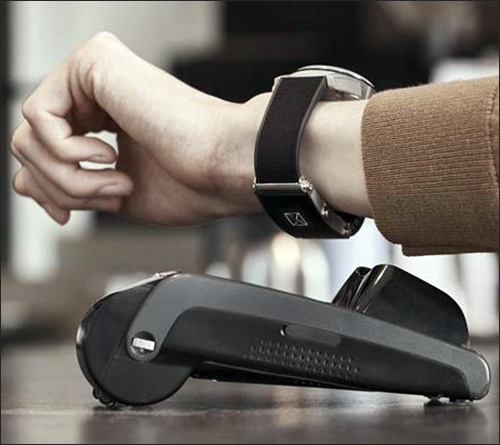Global financial services companies Mastercard and Visa have teamed up with NXP Semiconductors to provide a new Near Field Communication (NFC)-enabled payment wallet service to enable original equipment manufacturers (OEMs) to more easily add mobile payment functionality to their wearable, mobile and Internet of Things (IoT) devices.
Germany luxury watch company Montblanc is the first firm to use the service in its product. Montblanc will offer the solution with its Montblanc Pay app and TWIN Smart Strap watch for payments at any contactless-compatible payment terminals. “The consumer will be able to use the TWIN in the regions where we launch Montblanc Pay right away,” says Felix Obschonka, Montblanc’s director for new technologies. With the partnership between NXP and credit card companies, he explains, the firms intend to enable device manufacturers of any size to provide NFC payment services in a single, easy-to-launch solution.
There are already many companies offering some kind of NFC-based payment solution, says Charles Dachs, NXP’s VP of mobile transactions, but each has its own unique system developed by working independently with financial service providers, systems integrators and providers of NFC and secure microcontroller hardware and software solutions, which makes deployment of systems cumbersome. With an increasing number of device form factors emerging, he says, “It’s an extremely fragmented market.”
The mWallet 2GO solution is intended to be much easier, the company reports, as it is offered as a universal system that device manufacturers can adopt to provide consumers with access to payment options using the company’s own application. mWallet 2GO is based on NXP’s Service 2GO cloud service, launched in February of this year, to manage digitized Mifare product-based credentials that enable consumers with NFC-based access control to accomplish use cases such as transit payments. Companies are using this solution to enable their customers to make use wearable devices for payments.
The partnership with Visa and Mastercard takes the solution one step further, Dachs says, “by providing a full wallet for fast, simply and inexpensive implementation.” The mWallet 2GO system connects to Visa (VTS) and Mastercard tokenization platforms to tokenize users’ payment cards. “With mWallet 2GO, NXP is going to market with a true end-to-end solution that includes the mobile wallet,” Dachs states. “We are expanding our 2GO service from micro-based transactions to a full wallet solution.”
NXP will help companies integrate the NFC hardware into their devices. The solution is pre-integrated with NXP’s NFC and SE chips, Dachs reports. The companies can then use the SDK to set up the system within their own app, and link securely to Mastercard or Visa in order to enable user devices with tokenized cards. Tokenized cards are then stored within the SE of a user device.
Consumers would download an OEM’s app to their device, then set up the wallet by inputting payment card details to activate it. NXP’s software manages the provisioning of the secure token that links the device to the user’s physical card. When the user makes a payment, he or she can proceed to any NFC terminal and tap the device.
Montblanc has been working with the companies for about a year to help develop a system that could benefit brands and device manufacturers. In addition to watches, the firm makes pens and other luxury writing instruments, jewelry and leather goods. The company is building mWallet 2GO into its TWIN Smart Strap, and says the strap—which can enable payments via its Montblanc Pay app—is expected to be made available in August 2018 at a price of around $455.
The smart strap is intended to help spearhead a trend toward more connected devices for payments, Obschonka says. “We see broad adoption of NFC-based payment in wearables by consumers,” he states, “and, in particular, good traction in continuous and available use.” Therefore, he adds, the company built the NFC payment functionality as a core feature to the product, “to allow simple payment from your wrist.”
Users of the TWIN Smart Strap can tokenize their existing credit card into the wristband. That digital token can then be seen as a virtual copy of their credit card, with the same rights as the card when it comes to making payments. They can simply tap their wristband each time they make a purchase, and their account will thus be charged accordingly.
“We believe our customers will value convenient pay with the TWIN at any point of sale for any kind of transaction,” Obschonka says. The value, he notes, “is the simplicity of setting up the solution and using it, the compatibility globally with all contactless EMVCo devices and the high security standards of the solution.”
In the long run, Dachs says, the partnership will address more devices than simply wearables. He points to cars or home appliances as being NFC-enabled items that could accomplish transactions. In the immediate term, Dachs says, the partnership will enable “smaller players to come into the NFC market,” as well as larger companies with specific regional intentions.




